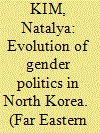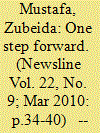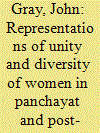| Srl | Item |
| 1 |
ID:
162797


|
|
|
|
|
| Summary/Abstract |
Broader rights and greater opportunities granted to Korean women have been priorities in social policy of North Korea. The liberation of Korea from colonial dependence presented the country's leadership with the task of doing away with semi-feudal holdovers, one of which was female discrimination in family and public life. Equality of the sexes was based on the socialist concept of women's emancipation. After the establishment of juche as the state's ideology in North Korea, the development of rights and duties of women has received a new ideological backing largely based on traditional Korean values.
|
|
|
|
|
|
|
|
|
|
|
|
|
|
|
|
| 2 |
ID:
093771


|
|
|
| 3 |
ID:
151951


|
|
|
| 4 |
ID:
139464


|
|
|
|
|
| Summary/Abstract |
This paper analyses the changes in the ways in which the diversity of women in Nepal has been conceived and represented from the Panchayat Democracy era in the 1960s to the current period of constitution-writing for a new federated state of Nepal. The various forms of diversity attributed to women—cultural differentiation, hierarchical differentiation, quantitative differentiation and substantive differentiation—have been and are being constructed in juxtaposition to various forms of unity—gender, universal, national unification and the ‘Third World woman’ in need of development. These varied configurations of unity–diversity have different implications for the women's movement and its quest to redress the historical subordination, oppression and exclusion that have been suffered by Nepali women.
|
|
|
|
|
|
|
|
|
|
|
|
|
|
|
|
| 5 |
ID:
170272


|
|
|
|
|
| Summary/Abstract |
The women's movement in Pakistan strategically used the courts to fight for rights-based empowerment over the last 40 years. Its demand to hold the state and judiciary accountable for delivering on its constitutional promise of fundamental rights has led to landmark public interest litigation jurisprudence. This paper presents for the first time the movement's full history of litigation in its key areas of concern: sexual and reproductive rights, protection from discriminatory laws and informal justice mechanisms, socio-economic and environmental rights and political rights. Achievements include positive verdicts, sensitizing judges, progressive legislation and increased public awareness.
|
|
|
|
|
|
|
|
|
|
|
|
|
|
|
|
| 6 |
ID:
120963


|
|
|
|
|
| Publication |
2013.
|
| Summary/Abstract |
Using unique survey data collected in 2000 and 2010 and a novel approach to the study of women's movement, this study examines the extent to which the women's movement has persisted and/or changed over the past decade in South Korea. The core emphasis of the paper is on whether Korean women's organizations have changed mobilization repertoires that are important for movement formation, and if so, how and why. The findings indicate two things. First, on one hand, the women's organizations have displayed similar patterns of resource mobilization (i.e., financial situation) over a ten-year period. On the other hand, women have used or have been willing to use different political tactics and alliance strategies to pursue their goals. Second, the younger women's groups, compared to their older counterparts, have collaborated more among themselves and have also been more satisfied with other public and private sectors in addressing women's issues and formulating appropriate policies.
|
|
|
|
|
|
|
|
|
|
|
|
|
|
|
|